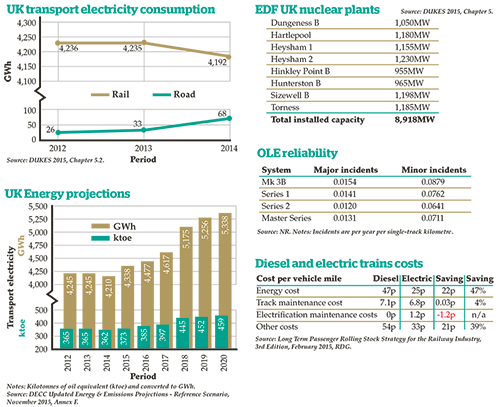In the 1980s, British Rail faced a battle to persuade government to authorise East Coast Main Line electrification to Leeds and Edinburgh. This was estimated at £212m in 1982, authorised at £306m in 1983, and completed for £319m (1983 prices, £911m in 2012 prices to give a comparison with GW).
While arguing for ECML wires, BR closed its electric route across the Pennines, amid falling coal traffic but barely 25 years after running the first electric train on the Manchester-Sheffield-Wath route. In British Rail 1974-97, railway economist Terry Gourvish suggests that this closure did not help BR’s case, but Eastern Region General Manager Frank Paterson (responsible for the line at its closure in 1981) has said he was convinced that the closure influenced government to approve the ECML wires.
BR tightly controlled ECML wiring costs. It has become fashionable to criticise the route’s electrification as unreliable, noting the apparent ease with which the wires have fallen and the disruption that results.
Although not citing the ECML scheme explicitly, NR said in January 2013 in A Better Railway for a Better Britain: “In the past corners were cut when electrifying lines. Ultimately passengers are paying the price for that decision, with disruption today. The cost of replacing this sub-standard equipment is far higher than if the job had been done properly the first time.”
Yet it’s difficult to see Margaret Thatcher’s government authorising the ECML scheme if the initial estimate of £212m had tripled to around £650m, as NR’s GW plan has.
The ECML scheme stretched the distance between masts to the limit, so needed fewer masts. It also used wire headspans over sections with more than two tracks. This also reduced the number of masts and foundations and does not need steel girders spanning tracks, lowering costs (although the masts were taller). German railways make extensive use of headspans. ECML reliability has improved since maintenance was increased.
The response to criticism of the light and cheaper electrification of the East Coast has been to design a new overhead line equipment (OLE) system that is much more substantial and much more expensive. Hence Peter Dearman’s comment to 2015’s IMechE conference: “Any idiot can throw money at a problem.”
Dearman was very critical of the latest OLE designs, claiming that they were over-engineered and too conservative, with components that were too big and too expensive. “If we ignore this, we’ll have another electrification plan that’s failed,” he argued.
Early OLE schemes were heavily engineered. They had to be because Britain had settled on 1,500V DC as its standard. DC systems need hefty cables to cope with the high current they need, and demand frequent sub-stations to cope with voltage drop.
The British Transport Commission’s 1955 report into main line electrification found that a track mile of DC electrification needed 9.0 tons of copper and 24.0 tons of steel, while AC needed 2.9t and 20.0t respectively. It considered London-Manchester/Liverpool, and estimated that the DC system needed 70 sub-stations (and a lineside 33kV cable along half the route to feed them), whereas AC needed just 12.
It was this 1955 report that recommended BR adopt 25kV AC as the new standard. OLE design was then refined through Mk 1, 2 and 3 designs over the following years.
Network Rail’s latest Series 1 and Series 2 designs cope with lines above and below 100mph. It is slowly installing Series 1 OLE along the Great Western Main Line, and installed the first mile of overhead line (albeit just an earth cable, not the more complex catenary and contact wires) on the night of November 12 2015. For context, NR should have completed a 16-mile section by September 1 2015 to allow tests to start with the route’s new trains.
Furrer+Frey designed Series 1 for speeds up to 140mph. It claims the new kit will bring reduced capital and whole-life costs, a longer life, reduced supply chain complexity by using standard parts, and improved electrical connections allowing higher fault currents. It says that existing OLE systems cannot be used because train operators want to run longer trains with up to three pantographs (as 12-car trains on ECML, WCML and Great Eastern Main Lines do already), and that standards are getting tougher so “it needs to deal with everything the world throws at it”.
Back in 2013, NR said that it had rejected using off-the-shelf European designs because they would need to be redesigned for UK use, and because they were not suitable for its high-output installation trains.
Series 1 can use a single mast for each pair of tracks. To this mast is attached a cantilever using a hooked connection that is quick to install. From that cantilever a vertical piece has two insulated arms that hold catenary and contact wires. Longer arms are available where designers decide to install a mast adjacent to each track. These arms have a single insulator in place of the two seen in other designs - this has the advantage of reducing the area of live electrics, by placing that insulator further from the mast. Series 1 can use steel portals for lines with four tracks (or more), with the portal spanning the tracks.
To keep the OLE under tension, Series 1 uses Tensorex C+ reels that Furrer+Frey says are lighter and easier to install, in place of the pulleys and weights of older systems. The reels also allow each wire to be held under tension independently of other wires. That means that if something fails, there’s less chance the wires over other tracks will be affected. Network Rail has installed Series 2 OLE between Liverpool and Manchester. Series 2 is fit for speeds up to 100mph, and uses heavier wires at higher mechanical tensions than Mk 3D OLE. It uses Tensorex reels and aluminium cantilevers (which have 11 components compared with the 32 in a classic cantilever).












